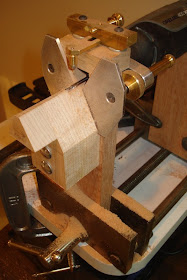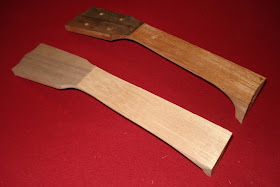The game is made from two pieces of 1/2 inch oak that are glued together after the chase was cut using a scroll saw. The 1/2 inch board that I bought was nice and straight but I didn't bring a straight edge with me and I found when I got home that it had a significant cup to it. I built a jig that clamped across the board and when tightened down, it flattened out the cup so that I could cut the raceway. If I didn't do this, the raceway would have sides that were not perpendicular to the game and the balls could hang up when moving through the game. The two pieces were glued with the cups facing opposite directions so that the glued up board was relatively flat. The raceway includes two chases where maple springs were mounted. The first sits by the top entry hole where the balls are inserted into the game. This spring presents minimal resistance to insertion of the balls but prevents the balls from leaving the game board (and keeps you from having to search your floor for bouncing ball bearings). The second spring has a button attached to it that when depressed, moves the spring out of the way and allows the balls to leave the game via the side hole. A piece of 1/8 inch plexiglass covers the bottom and allows you to see the ball bearings in the game (half of the "cool factor" of the game).
If you are not familiar with Hi-Q (aka solitaire in the UK I am told), here are the instructions.
Object:
Try to be left with just one ball.
Try to be left with just one ball.
Set Up:
Place the balls on the game board, leaving just the center hole empty.
Place the balls on the game board, leaving just the center hole empty.
Playing:
You can jump over a ball with another ball horizontally or vertically (not diagonally!).
You can jump over a ball with another ball horizontally or vertically (not diagonally!).
When you jump over a ball, you can remove it. Multiple jumps with one ball are allowed.
Scoring:
When you have no jumps left, count how many balls are left on your board.
6 or more left ...................................... BETTER LUCK NEXT TIME
5 balls left ........................................... NOT BAD
4 balls left ........................................... VERY GOOD
3 balls left ........................................... EXCELLENT
2 balls left ........................................... SENSATIONAL
1 ball left .............................................. OUTSTANDING
1 ball left in the center hole ................... PERFECT HI-Q GENIUS
When you have no jumps left, count how many balls are left on your board.
6 or more left ...................................... BETTER LUCK NEXT TIME
5 balls left ........................................... NOT BAD
4 balls left ........................................... VERY GOOD
3 balls left ........................................... EXCELLENT
2 balls left ........................................... SENSATIONAL
1 ball left .............................................. OUTSTANDING
1 ball left in the center hole ................... PERFECT HI-Q GENIUS


















































